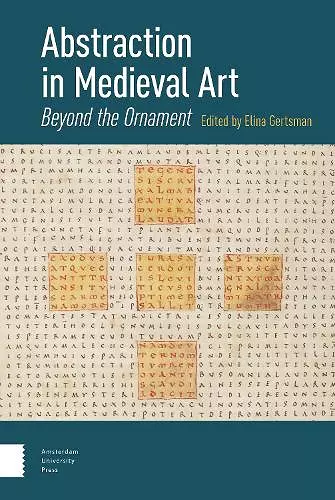Abstraction in Medieval Art
Beyond the Ornament
Format:Hardback
Publisher:Amsterdam University Press
Published:28th Feb '21
Currently unavailable, and unfortunately no date known when it will be back

Abstraction haunts medieval art, both withdrawing figuration and suggesting elusive presence. How does it make or destroy meaning in the process? Does it suggest the failure of figuration, the faltering of iconography? Does medieval abstraction function because it is imperfect, incomplete, and uncorrected-and therefore cognitively, visually demanding? Is it, conversely, precisely about perfection? To what extent is the abstract predicated on theorization of the unrepresentable and imperceptible? Does medieval abstraction pit aesthetics against metaphysics, or does it enrich it, or frame it, or both? Essays in this collection explore these and other questions that coalesce around three broad themes: medieval abstraction as the untethering of the image from what it purports to represent; abstraction as a vehicle for signification; and abstraction as a form of figuration. Contributors approach the concept of medieval abstraction from a multitude of perspectives-formal, semiotic, iconographic, material, phenomenological, epistemological.
"An excellent collection of thoughtfully selected, intelligently argued, and well-researched essays on an important topic."
- Richard K. Emmerson, Florida State University
"Absolutely original; startlingly and refreshingly innovative, both theoretically and empirically... the opening salvo in a completely new conversation that has never, as yet, been had in the academic world, and whose time, most definitely, has arrived."
- Marc Michael Epstein, Vassar College
"[...] the reader of this volume comes away buzzing with the pleasant frisson of inspiration, thinking eagerly of how future scholarship will expand on the project initiated here."
- Frances Lilliston, Comitatus, Vol. 53, 2022
“Gertsman’s collection of essays offers a rich set of studies that challenge ideas of abstraction and ornament, and art-historical conceptions of medieval art. [The] essays here offer a convincing sense of the possibility of these visual elements to represent, and indeed enable, interaction with the mysteries that preoccupied medieval conceptions of humanity, divinity and the world – both the literal within which one lived, and the broader universe which one could not see.”
- Millie Horton-Insch, Art History, Vol. 45, Iss. 4
ISBN: 9789462989894
Dimensions: unknown
Weight: unknown
384 pages